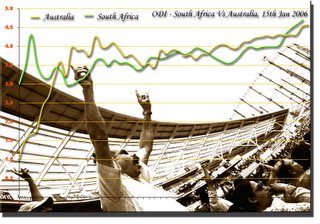Sunday, January 29, 2006
In suspension
Will not be able to post regularly for the next few weeks as I am extremely busy with work, travelling etc.
Aplogies...
Sunday, January 22, 2006
Predicting the Predictable - II
In the previous post, I had highlighted some of the most important attributes and also, in my opinion, flaws of the one day game, namely:
- There exists some kind of a par 1st innings score that gives both teams an equal chance of winning
- If the game moves away from this par score, the chances of winning and losing change dramatically. And so do the margins of victory and defeat.
Fair enough. Frankly, even I had my doubts before I started this analysis couple of weeks ago. Since then, I have analysed the One-day game to see if the above mentioned attributes do exist and are common to ODIs in general. I did this by grouping ODIs together based on different parameters.
First, here is a comparison of games played in this decade (2000 thru 2005) with all games played since 1971.
Note, as mentioned in my previous post, these graphs do not include games decided by the D/L (or similar) method, less than 45 overs (as they distort the numbers) and those that did not finish in a +ve result (i.e. "No Results" due to rain). Also note that in this (and all graphs), the line going from bottom left to top right represents the % times the team batting first has won after scoring the runs represented in the "x" axis, and vice versa. This gives us a par score (50% chance of winning or losing) where the lines intersect.
 (Please click on this and other graphs to enlarge)
(Please click on this and other graphs to enlarge)As you can see, apart from the difference in the par score, both those graphs are similar. And as expected, the par score in the games is a bit higher for games played in this decade.
Now, given the fact that ODIs in the sub-continent are normally higher scoring than the rest of the world, I split the games between those played in the sub continent and elsewhere and did a similar comparison...
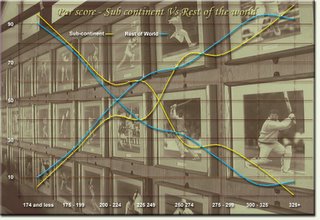
The sub-continental graph does appear "wonky" but on close inspection, it exhibits exactly what I am trying to prove, i.e. outside of the par score, the result becomes predictable, and in this case, its just more pronounced. And again, as expected the par score is higher for the sub-continental games. Guy who might still be holding their sheet of paper tick or cross your answers :-)
I was also aware that this split based on regional lines may not be correct, as not all grounds in the sub-continent are high scoring and vice versa. In order to eliminate this, I split the games based on the average run-rates for individual grounds. I used 4.50 RPO as the basis for the split (simple because this gave me about 1,000 ODI s on either side). And here is what I came up with...

And, just to be absolutely sure that all the above graphs did indeed exhibit more or less similar characteristics, I merged all of them into one graph...
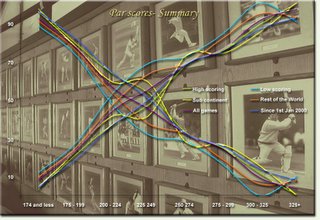
Funny enough, any which way you slice and dice this damn game, it does not seem to change. I am sure if I had picked up a random group of ODIs, I would have seen the same result. i.e., existence of some kind of par score, and either side of it, the game starts to get one sided.
Now, you may ask, so what, is this really a problem? In my opinion, yes, because given the 1st innings total, and with enough knowledge of the ground, era, etc, it becomes easy to predict the outcome of the game. And I am talking of games involving two evenly matched teams, (not Australia Vs Namibia kind).
And anyone need further convincing need not look any further then the last few games of the VB series being played in Australia. In fact, next time you sit down to watch a One-Day game; try to guess the result after the first innings is over. And see how many times you are correct.
Now, logically speaking, if there is a par score, it implies that most 1st innings scores should be finishing around that score, no? Well, this is another aspect of this whole analysis that struck meas odd (and something i have not been able to understand). See the % of games that fall into these different "run-bands"...

Talk about similarity here!!
Now, it would be appear that the ideal situation would be for more games to have the 1st innings scores around par score as it would be difficult to determine the result of those games. Frankly, this would make the whole game boring and the excitement would only kick-in at the death of the second innings (say 5-10 overs left). A bit like the 250-270 games we are so used to seeing in the sub-continent.
So is there another solution by which no matter what the situation of the game at the mid-point, it becomes difficult to predict the result? Or in other words, can the element of par be eliminated?
In my opinion, it can. But not by making flat pitches or introducing meaningless rules like Powerplays or Super-subs. All they do it increase the runs being scored in the game but, as I just proved, does not change the nature of the game...

Anyway, to understand how this par can be eliminated, I will need to compare ODIs with other "Set-target, Chase-target" kind of games like Test cricket and Baseball (actually, none other come to mind)!
And as a starting point, I will analyse how easy (or difficult) it is to determine the par score in Test cricket and why.
But that in my next post.
Friday, January 20, 2006
The Lahore Fiaso...
And finally, a casual thought for the curator and Inzaman who are getting their share of blame for this pitch.
And what about the greedy morons (BCCI, PCB, etc) who decided that it would be a great idea to schedule a Test in
If they lacked local knowlegde of the weather, maybe they should have checked the dates when Tests have been scheduled in Lahore in the past...
 (click on image to enlarge).
(click on image to enlarge).For those of you wondering what happened to the only other Test Match that was played in January, check this. And yes, it was the poor Kiwis who decided that losing a Test match inside 3 days was better than sweating it out for 5 in the first week of May in the sub-continent.
Like I said before, scheduling Test matches is a science, but rocket science…
Thursday, January 19, 2006
These damn schedules again...
Why do we keep going around in circles as far as this scheduling is concerned. How difficult can it be to get 10 nations to play each other on a consistent basis?
Frankly, any sensible person could spend a weekend and come up with something more sensible that what the ICC and the various boards will ever come up with. After all, its not rocket science.
But I said "sensible"…
Anyway, just to prove a point, I spent all of 10 minutes (in the middle of a very busy morning) and came up with this simple schedule for India that takes into consideration what India want (i.e. play more against Australia , England and Pakistan ) without upsetting the ICC Test Cycle.
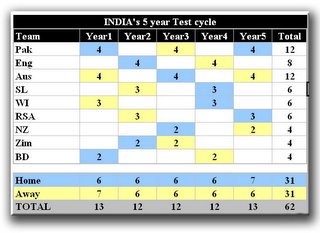
(click on image to enlarge)
And in those 10 minutes, I also had time to colour code this damn thing!
I now things are not as simplistic, but I also feel that there is nothing that cannot be achieved by sitting down on a table and discussing things.
Just make sure you have a laptop with Microsoft Excel loaded on it...
Wednesday, January 18, 2006
Predicting the Predictable
Anyway, this post is more to do about the One-Day game and less to do with Test cricket (though they are related in a vague sort of way).
Before reading any further, ask yourself this question; when you sit down to watch a one day game does a par score cross your mind, i.e., a score after the first innings that gives both Teams an equal chance of winning? And after the 1st innings is over, do you have a gut feeling as to who will win (or lose) the game? And are you more often right then wrong?
If the answer to all these questions is no, then you haven'’t watched enough one day cricket, but read on nevertheless J
And if the answer is yes, then welcome to the club. In this case, pick up a pen and paper and write down the rough par scores that come to your mind based on all* ODIs played:
- World wide since the early 70'’s
- World-wide since
- In the sub continent
- Outside the sub continent
* Excluding games decided by D/L (or similar) method, less than 45 overs (as they distort the numbers) and those that did not result in a +ve result (mainly due to rain, but occasional Ties)
I am looking for four answers here (one for each) but let me clarify, I do not expect anyone to come up with accurate answers. The main idea (apart from a bit of fun) is to see if such numbers do spring to mind.
Now to proceed. I had mentioned in one of my earlier posts that higher the 1st innings score, the more the chances of the team winning. As a refresher, here is the graph from that post (ignore the comparison with Test cricket for the moment) …
(click on this and other images to enlarge)
And since we know that in the one day game, unless there is rain interruption or a tie (which is very rare), if you are not winning, you are losing. If we exclude these '“No Result' games, the losing line is a mirror of the winning line, we get a graph in which the lines cross each other at the 50% mark (donating a point when the chance of winning or losing is equal, or at Par).
(Based on all* Games world wide)
And there is another striking aspect of the game; not only does the chance of winning (or losing) change dramatically once you move from the par score, the margins of victory (or defeat) also change dramatically.
(please note, I have used nr of balls left as the margin of victory if Team batting 2nd wins as opposed to the traditional wickets margin).
Now, in my opinion, these graphs highlight some of the most important attributes (and also flaws) of the One day game:
- Some kind of par score exits
- It exists EXACTLY in the middle of the game
- If the game moves away from this par score, the chances of winning and losing change dramatically. And so do the margins of victory and defeat.
So the moment the 1stinnings score moves away from the par score, its starts becoming predictable move. So how many games finish around the par score and how many out side it?
As you can see, only about 25% -30% games do finish around the par score. So about 70-75% games finish outside the par score and the further they are from that score, the more one sided they get.
Now, in the ideal world, it would be great if all games finished around the par score. But that would mean that the 1st Innings would be come predictable and boring J We can'’t win, can we…
Anyway, got to rush now. Travelling, work etc will keep me away for a couple of days.
But don't throw away your tiny sheet of par scores as we still need to find out how the game has changed in the last few years and how sub continental games differ from elsewhere. And feel free to revise those scores. After all, there are no prizes for guessing correctly J
Tuesday, January 17, 2006
From the Rediff archives
The "ideal" Test championship
The ICC's system - a rating or a Championship
Building a Perfect World Championship schedule
Analysis - ICC Vs PWC
Accommodating One Day Internationals
The reason I have put the link here? Because I heard that the BCCI finally want to play 12 Tests and 30 ODIs every year, that too with Major countries and don't care a hoot about the ICC Test Championship.
Can't blame India. Frankly, does anybody really care about the Championship which (as I pointed out 4 years ago) was a badly implemented idea (Like most things we have come to expect from the ICC).
I admit the "perfect" schedule I have proposed in these articles is far from perfect, but I came up with it one weekend on a excel spreadsheet. And didn't make millions of dollars for doing it either :-)
Enjoy...
Monday, January 16, 2006
The Lahore Pitch...
While I am in the middle of an analysis highlighting the virtues of Test cricket (over ODI’s), this (pitch) seems like a conspiracy against my blog.
Anyway, I am sure there is still hope that something can be done to put some life into the Lahore pitch like…
- Placing a dummy in the middle of a Rugby stadium in UK and informing the Americans that Bin Laden has been spotted playing ball in Europe. And wait for them to land a few cluster bombs with pin point accuracy (one must add) at the Gadaffi Stadium in Lahore, causing just about enough damage for Kaneria to turn the ball. And to minimize collateral damage, just make sure only the curator of the ground is present near the pitch. …and Ganguly.
- Getting experts like the Shiv Saniks who can alter the conditions of the pitch overnight.
- Asking all right-handed Indian batsmen to bat left handed and vice versa, and hope they get out quickly. Except Ganguly. Why bother...
- Selling the rights of the Lahore pitch for $10 million to Nike, so they can swoosh it with their logo. That might just do it.
- Blow up a cylinder in the stands and wait for Afridi to do his little "twist & turn" routine. Again to minimize loss of life in the stands....
- Allowing the Pakistani bowlers to bend their arms by 30 degrees so they can extract some life out of this pitch. On second thoughts, it wont make any difference to either Akhtar or Malik.
- Allowing a special Super-sub rule for the last day of the Test, so that Pakistan can sub 10 of the Indian batsmen…with Ganguly. And make sure he bats left-handed...
Any more suggestions?
Sunday, January 15, 2006
South Africa-Australia run rate...
Who needs boring draws?
Well, Indian fans can take solace from the fact that while India’s chances of winning this game are virtually nil, they can still finish with a ‘favourable’ result. For Pakistan's point of view, the game is not in the bag and they still have to do a lot of hard work to win this Test.
Here is a graph showing a Team’s chance of winning or losing depending on the first innings score of a Test Match (based on all Test matches played around the world).
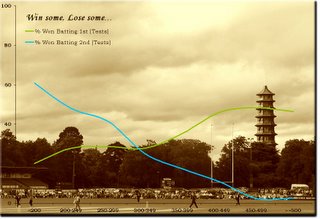
(click on this and all other images to enlarge)
As you can see India still have about a 50% chance of “not losing” this game because Paksitan have only a 50% chance of winning (simple math really), thus giving India the option to go for the draw. While we can all do without high scoring boring draws, we have to acknowledge that they form an integral part of Test cricket as they eliminate (or reduce) imbalances in the game.

Had this been an ODI game and Pakistan would have scored something similar (say 350+, which is, IMO, the equivalent to 650+ in Tests), the game would have been virtually sealed after the first innings, and Indian fans would have watched the game out of hope rather than expectation.
Here is how a Team’s chances of winning is linked to their 1st innings score (I have excluded rain excluded ODIs that were decided by D/L or similar methods)
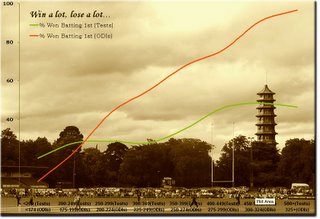
As you can see, because ODIs do not have the luxury of a draw, high scoring games tend to get very one-sided in favour of the Team batting first. So though 4s and 6s make seem exciting, too many of them in a game do not make a game exciting.
Now, while I am not trying to condone these kind of high-scoring games played on placid pitches, I would still take something like this to a high scoring ODI.
Very reluctantly, I must add...
ps. I had started this analysis before this game, hence I only have a 500+ column. In hind sight...
Saturday, January 14, 2006
Advantage India
ps. Statistically speaking, Pakistan have only a 57.9% chance of winning this game (after scoring more than 650 runs). However, had they scored 350+ in an ODI (which is my opinion is an equivalant score in that format, they would have had a 100% chance of winning (See my previous post sometimes more is less).
This is going to be the basis of my next few posts wherein I try to analyse the two formats of the game. Stay tuned...
(added 15/1/2006) Please see this
apologies
(not the mention the Ind-Pak Test)
Wednesday, January 11, 2006
Lahore, not a bad place...
So here is the comparative analysis of these four grounds for the last 5, 10, 15, 20 and overall* games:
Run rates (which also indicates the changing nature of Test cricket overall),

averages (runs per wicket),
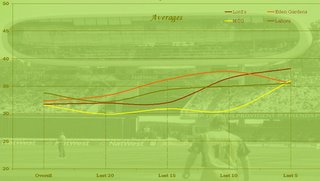
strike Rates (balls per wicket),
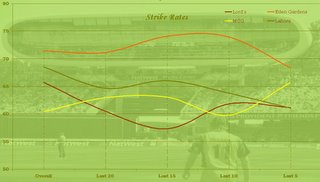
and lastly, result %
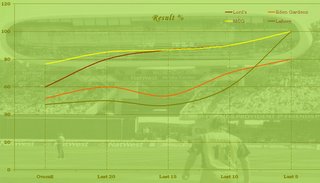
All in all, the Gadaffi stadium does not seem a bad place to be watching cricket. Hey, add a sexy media centre, tilt the ground a bit, and it will even start resembling Lord's. And a few bowler hats might even confuse your die-hard MCC member.
Hmm, never mind the last bit...
* For an apples to apples comparison, in the overall records figures, I have only included Tests played at Melbourne, Lords and Eden Gardens since 1959 (i.e., after the Gaddafi stadium hosted its first Test).
Sunday, January 08, 2006
Ganguly in Numbers
However, you can't help asking youself this question, if Ganguly is indeed our most successful captain, how good was he? How many did he win, and lose? What was his record against the leading nations, and against the minnows? What was his batting record as captain and how did it compare with Tendulkar, Dravid (in ODI's & Tests), Sehwag (in ODI's) and Laxman (in Tests)? And lastly, how did he compare with his peers like Vaughan, Inzamam, Ponting (!!) and Fleming.
I am sure you have all come across various stats regarding Ganguly, and here is yet another one, genuine attempt on my part to "codify" Ganguly in Black & White (ok, shades of pink, purple and blue)...
First his Captaincy record in Tests:

and in ODIs...

In one of my previous posts, I have briefly touched upon the performance of the Tendulkar & Dravid under Ganguly. I have also done a head-to-head comparision of his performance against Tendulkar.
But here is a more detailed analysis of how Tendulkar, Dravid and Sehwag performed under Ganguly in ODIs highlighting their contribution in games won/lost, etc.

And a similar comparision of Dravid, Tendulkar & Laxman in the Tests ( note this is only their record under Ganguly, so Tendulkar's 194* in India's win Pakistan in 2004 under Dravid does not feature).

Lastly, how did Ganguly compare with respect to his peers in the modern game? I have kept this comparision as a simple Win/Loss record in Tests and ODIs.
Here is his record compared to other modern day captains (with apologies to Chanderpaul, Taibu and Bashar).

And a similar record in ODIs...
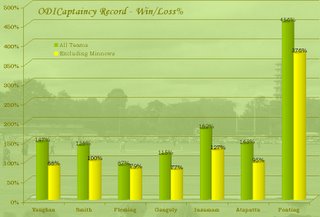
As I mentioned in the begining, it is difficult to codify Ganguly in numbers, but at least these numbers should remove (or rekindle) some of the debate around his legacy
Cheers...
Sometimes more is less...
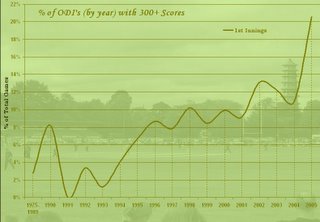
Wow, you will say, this is great. It means that the One-day game is getting more exciting. Fours, sixes (the works basically) and this is what we what to see.
Well, not exactly especially when you look at the number of times the team batting second has actually crossed 300 in the same games...

As you can see, teams batting second still haven't mastered the art of chasing high scoring games. The result is that the number of teams that win chasing a score of 300 or more is still very low.
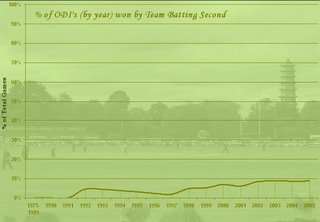
(this is a cumulative % and excludes games won on D/L method).
Also, not only do teams batting first (scoring 300 or more) win over 90% of the games, the average margin of victory stands at a staggering 101 runs!
I agree that when teams batting second do win or get close to the target (like the two games between NZ & Aus in December) the games tend to be great, but these games are few and far in between a load of one-sided encounters.
So at half time the 9/1 odds may look favourable, but don't be fooled and bet on the team batting second (not yet anyway).
Sadly, the only people who think that more is not less are the adminstrators who run this game. Bring on more Powerplays, I say, and see the % of 300+ scores shoot through the roof but don't put your money on an exciting game.
Anyway (on a slightly different note), its not all doom and gloom out there, as this suggests.

The number of ODIs being played over the years seems to be finally heading south and I hope its not just a blip...
postscript: Just watching the current Twenty20 game between
Saturday, January 07, 2006
No Black on White, no stats, but some story that...
Anyway, while I run around trying to find some more interesting stats, here is something for the weekend; my not so serious attempt at writing.
Hope you like it.
Friday, January 06, 2006
Twenty20
So, IMO, a better bowling attack is the one that has a "better" potential to take twenty wickets in a Test.
I made this point during the recent Ashes and showed how England had an edge over Australia in the bowling department and hence were better placed to take wickets. And in hindsight, it wasn't such a bad analysis :-)
Now, our very own "Bhai bhai Ashes" is being billed as the contest between the Pakistani bowlers and the Indian batsmen, thus giving the impression that the Pakistan has a "better" bowling attack than India.
Question is; is it? Lets see...
To determine which is the better, I have analysed both bowling attacks based on their "Wicket Taking Potential" (WTP, to coin my own abbreviation), which is the simple addition of the Wickets per match statistic of their front line bowlers.
I have assumed that the bowling attack for India will consist of Pathan, Kumble, Harbhajan and Zaheer (sorry Agarkar) and Pakistan will go with Akhtar, Sami, Naved and Kaneria.
Also, to get a better spread for analysis, I have determined the WTP based on the records from the last 5, 10, 15, 20 Tests and entire career. (Except in the case of Naved, who has only played in 7 Tests and Pathan, in 18).
Here it is...

As you can see, the Indians, on any given 5 days, can take about 3 more wickets that the Pakistanis thus making them a "better" attack.
Have I missed something here? Ah, yes! While I can chose to ignore part time bowlers like Malik, Shewag, Tendulkar and Yuvraj (ok Ganguly as well), Afridi is too good a bowler to ignore, as India found out at Bangalore last year.
So what does his inclusion do to the Pakistani WTP? This...
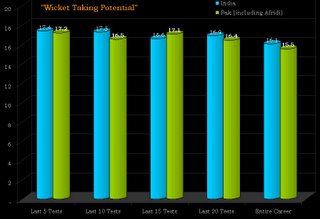
Though India still have their noses ahead, the difference becomes negligible. However, the balance now tilts in favour of Pakistan because (again old school thought) a five man bowling attack is better than four.
Now, this WTP analysis ignores an important aspect that also determines the quality of a bowling attack. It is the bowling average (number of runs given per wicket). Needless to say, if both bowling attacks have the same WTP, the one which gives away less runs wins.
I have used the bowling averages to determine the potential runs a bowling attack is likely to give away while taking 20 wickets, i.e. I have multiplied the bowling average with wickets per Test for each bowler, added it for the entire attack and normalised it to twenty wickets (for example, if India gives 340 runs to get 17 wickets, they will give 400 runs to get 20).
So how do both the bowling attacks compare in this department?
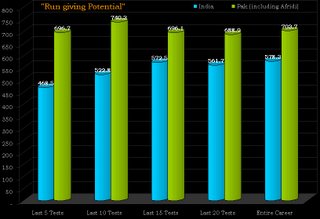
So no matter what the pundits say, reverse swing or not, I think the Indian bowling attack is miles ahead of Pakistan.
Having said that, when Akhtar steams in to bowl to Sehwag, all this counts for nothing...
postscript: Sometimes you don't need 20 wickets to win as the Aussies demonstrated today. In fact, this is the 11th time that a team has declared in the 3rd innings of a Test and lost. And the third time when a team has declared both its innings and lost (including the famous famous Cronje game at the centurion when South Africa scored 248/8 and then forfeited one innings along with England, and England scored 251 for 8 to win).
Wednesday, January 04, 2006
Serious Cricket Anyone?
As fans, we should all rejoice that the BCCI is ready to take a sensible stand, on behalf of us and the rest of the cricketing world. However, before we decide to open the champagne and celebrate, it will be interesting to look back and see how much meaningless cricket (against the minnows) the ICC has '“forced'” down our throats in the last six years.
I have done a brief analysis of all ODIs and Tests played by each country since Jan 2000. (click on all images to get the bigger picture).
First, the number of ODIs played by country
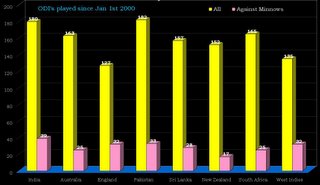
As you can see, India leads the pack, closely followed by Pakistan, England and the West Indies.
And now the Tests played, again by country…

Again, India leads the pack, which is even more surprising considering the amount of Test cricket we play.
Now combining the figures, we get the average days of cricket played per year (assuming 5 days of Test cricket, which is a bit rare against Minnows, but never mind).

Again no surprises there.
While you look at this chart, ask yourself this question; if the sub continent is indeed the centre of the cricketing World, why do India, Sri Lanka and Pakistan play less cricket than say West Indies, where the game is all but dead! Don'’t expect an answer anytime soon.
Ok before I proceed, apologies if I made you believe that India consistently plays 80 days of cricket every year. Just to clarify, this is the actual number of days of cricket being played (by country) every year since 2000, and as always, India continues to dominate both, the low and high ends of graph.

Pakistan probably has a genuine reason for an inconsistent schedule (due to security concerns after 9/11, etc) but how the BCCI managed to schedule 115 days of cricket in one year, and 53 the very next is beyond me! But I had made this point in one of my earlier posts, so I will pass.
Some of you may look at these numbers and say, yes India is on top because we play more cricket but overall as a percentage, we cant be that bad, can we?
Here is the answer.

And hence they are upset, and may I remind you, with the ICC.
Now if only the BCCI had bothered to find out how the other countries manage to play more cricket (and that to consistently) and less of the meaningless cricket in question, and yet adhere to the ICC'’s policy (however stupid it may be)?
But I guess it'’s a lot easier to pick up the phone and make a call across the Arabian Sea and shout foul.
Anyway, I do hope the BCCI knows what to do with the spare time once they decide not to play Zimbabwe and Bangladesh. After all, the next team to visit India after England (in Mar 2006) is Zimbabwe in October 2007, followed by West Indies in 2008!!! (Talk about Home advantage for the next two years)
So if India decides not to play Zimbabwe at the end of next year, we may not have any team visiting India for the next two years, unless we can convince someone to come down and fill in he gap. But last I checked, not many countries seem to have the spare time in their busy schedules. Well, there is always Bangladesh from across the border, but…
I guess the BCCI really donÂ’t care about this 2 year gap. They just want to play cricket (as long as it is meaningful) and if they can make the money via TV rights, what is the need to host cricket in India as all. With 70% of the tickets given away as passes, the real fans donÂ’t get to see the games anyway, so why bother with the logistics of hosting games for a few thousand rupees in gate receipts.
Anyway, in case you want to mark your calendars in advance (so as to stay away from your Television sets), according to the ICC schedule, India have to visit Bangladesh, host Zimbabwe and visit Zimbabwe in the next 5 years. A WHOLE 30 days of pointless Test cricket!!! As opposed to the 65 days of Test cricket that was forced upon us in the last 6 years.
Damn, I deviated in this post, as my point really was about the ICC and the crap it forces down the throats of the like of the BCCI, and not about the BCCI itself.
Never mind…
Sunday, January 01, 2006
Catch me if you can...
So, how do the other countries compare with the Aussies, and is the gap finally closing?
Here is the comparision of Run rates and Average runs per wicket (by year) between the Aussies and their opposition (in head to head games).

I know there is the Ashes factor in 2005 but can we hope to see the gap closing further in 2006?
Another vital stat to look out for this year...
The Punter and the Wall
When they first came face to face, they had scored 193 & 187 runs respectively (with 2 fifties each).
When they last met (in the ICC-XI Vs Aus "TEST" in 2005), they had both added over 7,000 runs to their names and were playing their 92nd and 94nd Test Respectively. And at the end of last year only 13 runs and 0.90 points in their average seperated the two.
And yes, both bat at Nr. 3, have 58 & 59 Fifty-plus scores in Test cricket, and also captain their respective sides.
Have their been any other players in Test Cricket whose careers have been so closely linked? Lara and Sachin come to mind...
Anyway, will be fun to see who gets to 10,000 first. I am tempted to put my money on Punter, now that he is finally ready to go over the wall, but I wouldn't like to bet against the Wall either...





